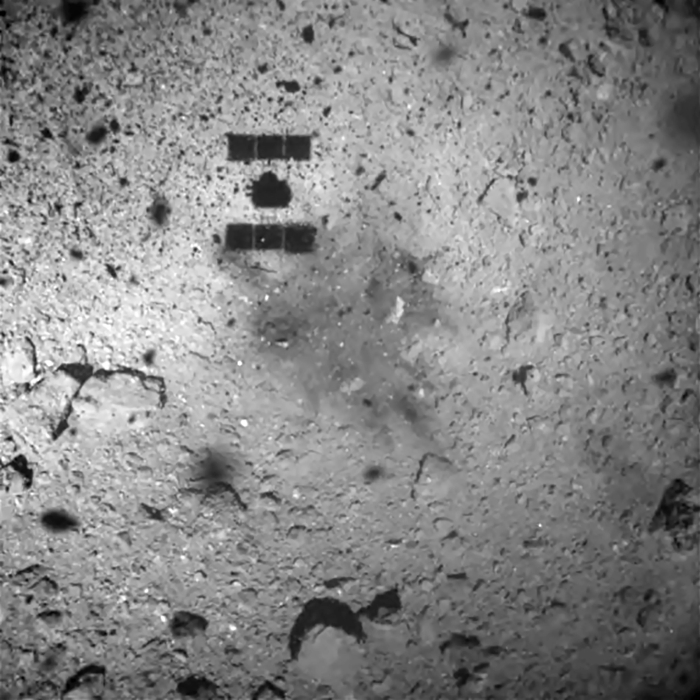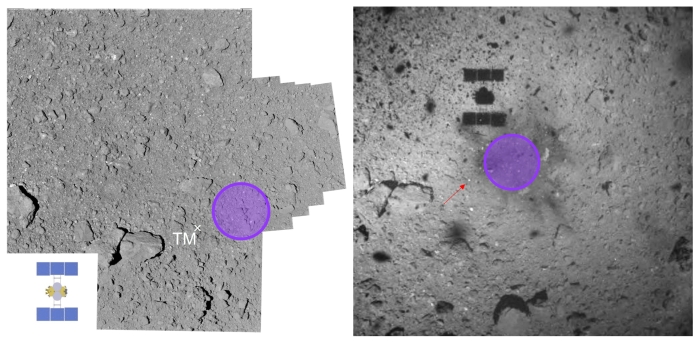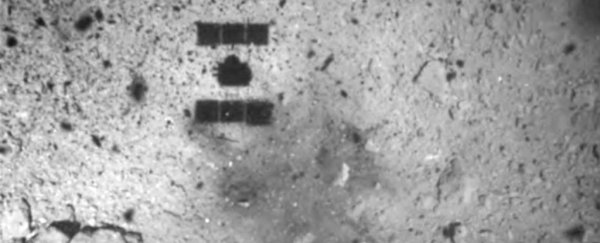Japan's space agency pulled off something awesome this week. Its spacecraft Hayabusa2 touched down on asteroid Ryugu, collected a sample, and jumped off again.
To remember this, we now have an epic photo of Ryugu's surface, potentially showing marks of that historic encounter.
Hayabusa2 actually arrived at Ryugu in June of last year, and dropped a pair of tiny, cookie-tin sized rovers to explore the asteroid in September. (Because they're so small, and the terrain so rough, these rovers get around by hopping across the ground.)
But the spacecraft didn't just go there to drop rovers. The most exciting part of Hayabusa2's mission is this - to bring an asteroid sample back to Earth.
Here's how you get a sample from an asteroid. On February 22, Hayabusa2 made its first touchdown on the surface of Ryugu - and fired a bullet at it.
Yep, it shot a tantalum bullet at a velocity of 300 metres per second (984 feet per second) into the surface of the asteroid. This impact kicked up material that - hopefully - made its way into Hayabusa2's waiting collection canister.
 (JAXA, University of Tokyo & collaborators)
(JAXA, University of Tokyo & collaborators)
In all, the encounter took less than a minute. The new image was taken one minute after touchdown, when the spacecraft had already bounced off the asteroid and was looking back from an altitude of about 25 metres (82 feet).
The picture shows the spacecraft's shadow as it ascends, along with mysterious dark marks on the landing site that had not been there before touchdown.
There's a helpful markup of this in the image below - the purple circle shows the landing site before (left) and after (right). The red arrow points to the guiding target marker Hayabusa2 dropped onto the asteroid prior to touchdown.
 (JAXA, University of Tokyo & collaborators)
(JAXA, University of Tokyo & collaborators)
"At the moment," the Japan Aerospace Exploration Agency (JAXA) wrote on its website, "the reason for the discoloration is unknown but it may be due to the grit that was blown upwards by the spacecraft thrusters or bullet (projectile)."
Thankfully, we might have a chance to observe the phenomenon again. This was just the first of three sample collection touchdowns - which means there will be two more before Hayabusa2 says goodbye to Ryugu and embarks on the long journey home in December of this year.
We'll be interested to see those touchdowns. And, of course, what we learn from the Ryugu samples - and how they compare to samples of asteroid Itokawa, brought to Earth by the spacecraft's predecessor, the original Hayabusa, in 2010.
